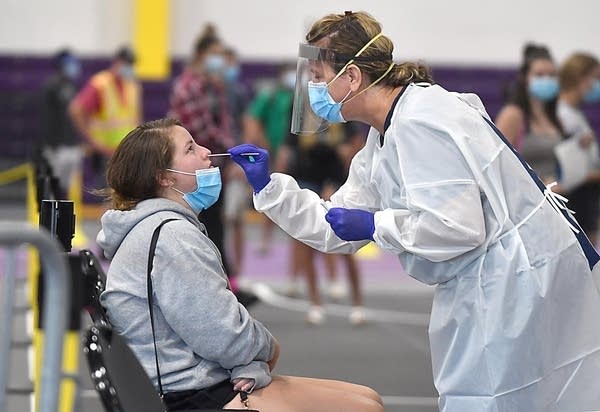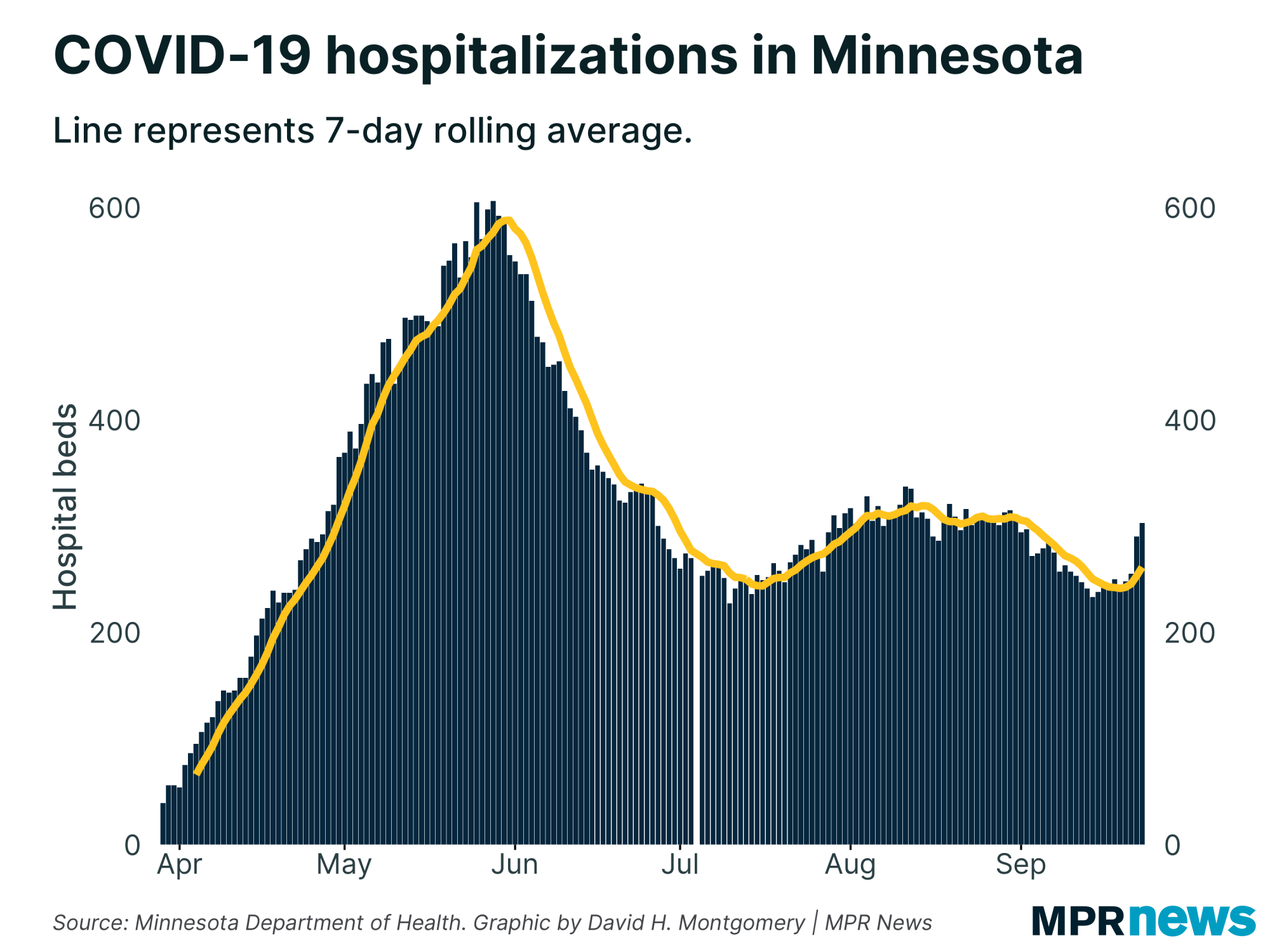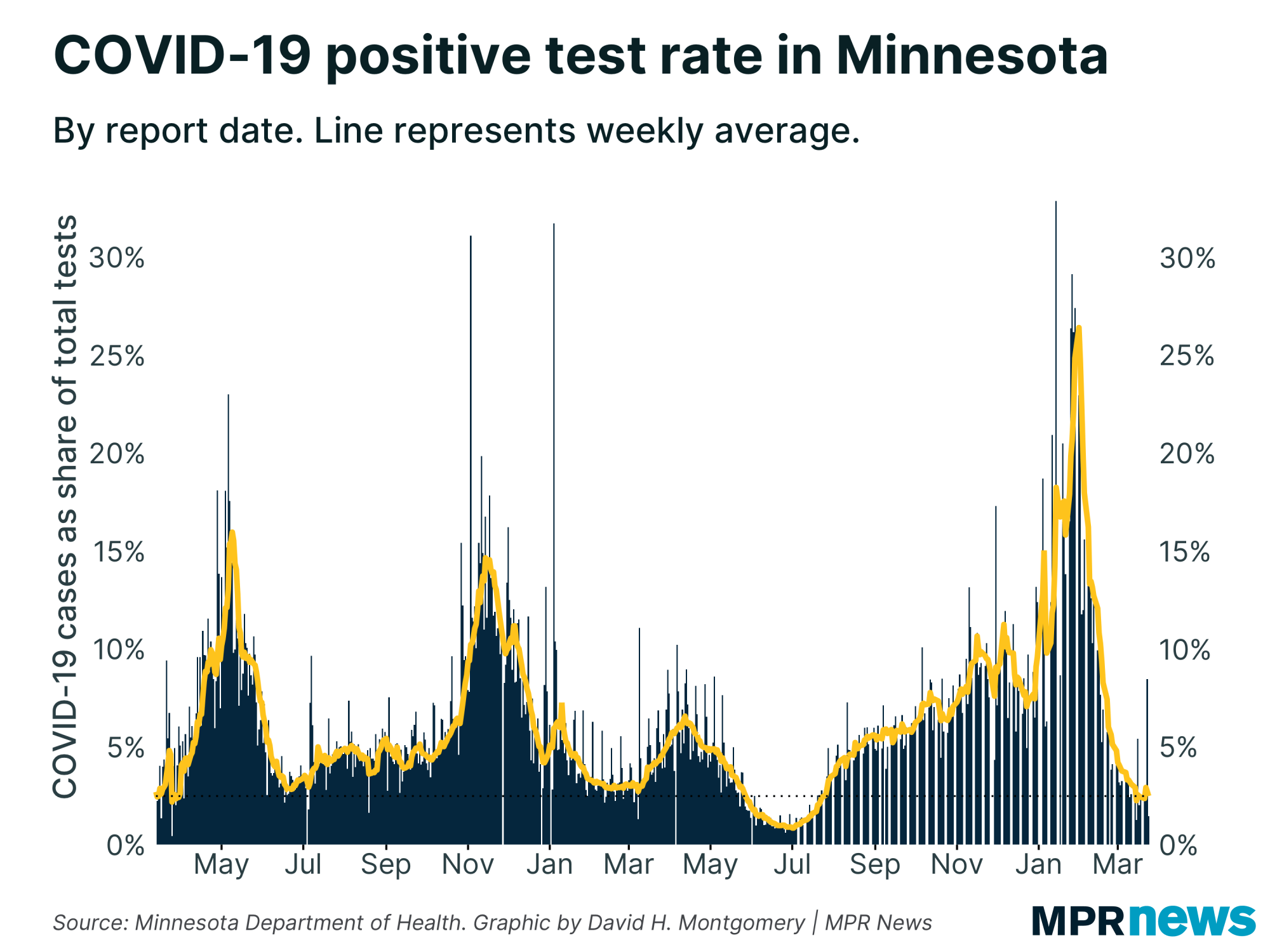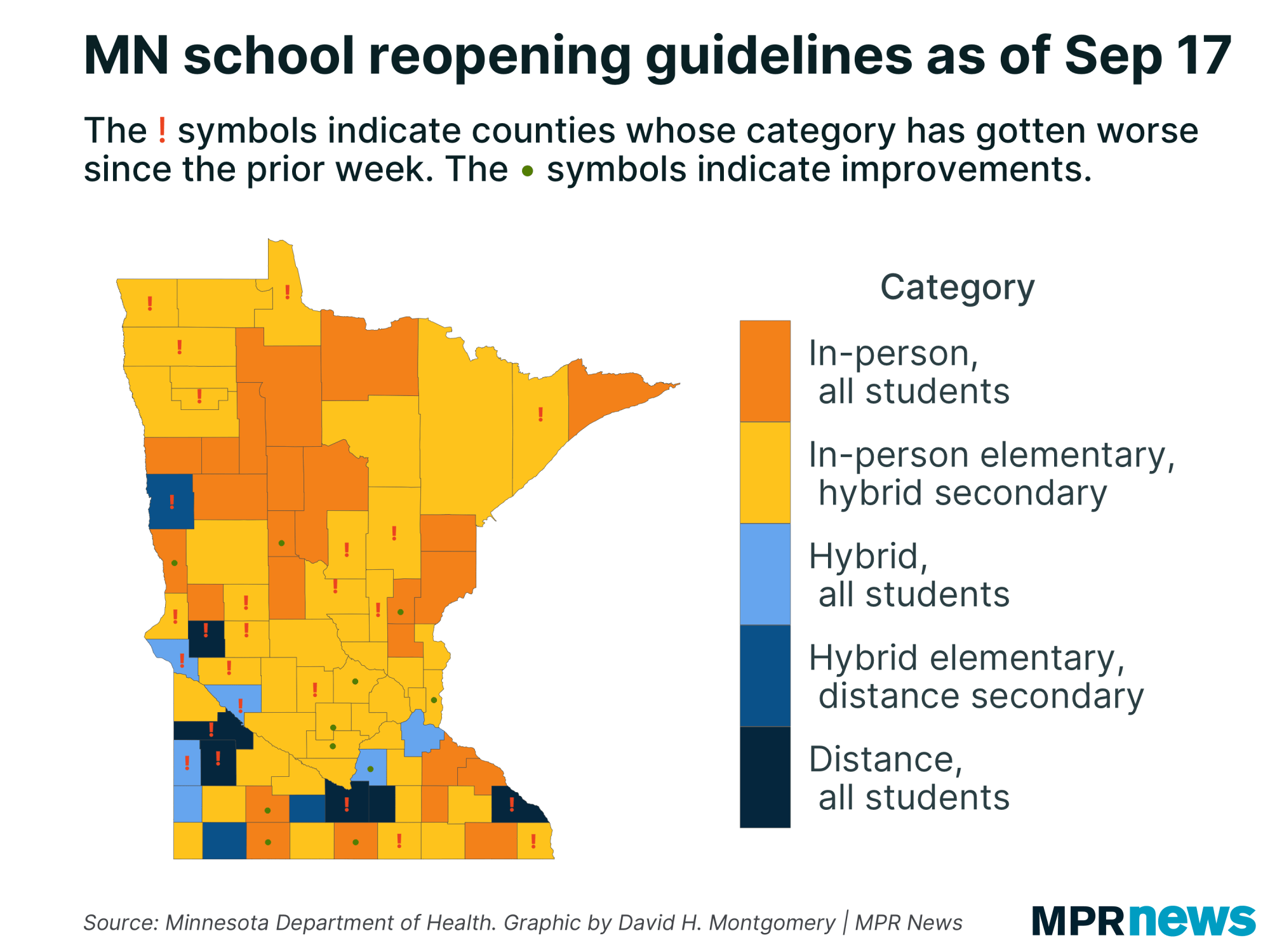Sept. 22 update on COVID-19 in MN: Hospitalizations, ICU cases climb

Go Deeper.
Create an account or log in to save stories.
Like this?
Thanks for liking this story! We have added it to a list of your favorite stories.
Updated 11:44 a.m.
Minnesota’s newest COVID-19 data shows two closely watched measures on the march.
The number of people currently hospitalized (290) jumped by 35 in Tuesday’s Health Department report, one of the biggest single-day increases since the pandemic began. The subset of patients needing intensive care (136) also rose.
Both were trending down in early September but have been pushing back up in recent days. While they remain far lower than their late-May peak, hospitalizations are trending up toward where they were in August.
Hospitalizations and ICU cases are key metrics for public health authorities as they try to manage the spread of the disease so it does not overwhelm the state’s health care system.
Turn Up Your Support
MPR News helps you turn down the noise and build shared understanding. Turn up your support for this public resource and keep trusted journalism accessible to all.

The Health Department reported only 513 newly confirmed infections on Tuesday, roughly half the pace of the past few days. However, testing was also down by about half. The percentage of people testing positive is also ticking up.
Of the 91,422 confirmed cases of the disease in the pandemic to date, about 91 percent of those infected have recovered to the point they no longer need to be isolated.

Ten more deaths reported Tuesday bring Minnesota’s toll to 1,979. Among those who’ve died, about 72 percent had been living in long-term care or assisted living facilities; nearly all had underlying health problems.
‘Not a record that we’re pleased about’
State health leaders have hammered home warnings that the COVID-19 pandemic is not nearly over despite fairly low daily death counts and what had been a relatively stable number of hospitalizations.
Some 2,200 cases reported over the weekend with another 900 on Monday appeared to prove that point.
As of Tuesday, the state showed 6,610 active, confirmed cases, down slightly from Monday’s pandemic record but still far higher than the current seven-day average of 5,901.

“We have seen a high count of new cases in recent days” that can’t be attributed to a testing results backlog Kris Ehresmann, the state’s infectious disease director, told reporters Monday. “It’s not a record that we’re pleased about.”
As they implore people to wear masks in indoor public spaces, socially distance and take other measures to check the spread of the disease, officials are expecting cases to rise from get-togethers and other informal events during the Labor Day weekend, when people may have let down their guard against COVID-19.

They also have a new set of concerns — state high school sports officials on Monday agreed to stage fall seasons in football and volleyball weeks after saying they would postpone those seasons so as not to spread the disease.
While the state is seeing “positive trends” in hospitalizations and deaths, Minnesotans should not start thinking that COVID-19 isn’t serious, Ehresmann said. Experts are just now learning about the long-term health consequences among who were infected even with mild symptoms, she noted.
College campus worries rise
People in their 20s make up the age bracket with the state’s largest number of confirmed cases — topping 21,000 since the pandemic began, including more than 12,500 infections among people ages 20-24.
The numbers help explain why experts remain particularly concerned about young adults as spreaders of the virus.
While less likely to feel the worst effects of the disease and end up hospitalized, experts worry youth and young adults will spread it to grandparents and other vulnerable populations and could also hamper attempts to reopen campuses completely to in-person teaching.

They’ve been driving the recent outbreaks, although the number of high school-age children confirmed with the disease has also grown, with more than 8,600 total cases among children 15 to 19 years old since the pandemic began.
Regionally, southern and central Minnesota and the Twin Cities suburbs have driven much of the increase in new cases while Hennepin and Ramsey counties show some of the slowest case growth in the state.

Hot spots have included southwestern Minnesota, where 75 cases have been traced to a late-August wedding in Lyon County that officials describe now as the state’s largest single social spreader event.
Waseca County has also seen a relative surge. Last week, state analysts confirmed an outbreak of 122 cases at the federal women’s prison in Waseca, which they said began when federal authorities transferred people into the facility from outside the state who had COVID-19.

Schools and sports
With many schools in Minnesota returning to in-person instruction in school buildings, officials have been keeping close watch on caseloads reported by schools.
Ehresmann on Monday said there are 351 schools in Minnesota currently affected by at least one case: 263 have one; 81 with two to four cases; seven are dealing with five cases.

She also expressed concern about reports of “apparent reluctance” among adults to disclose that they or their children have been confirmed with COVID-19 and not cooperating with health investigators trying to trace the disease.
“It boosts the risk of spreading COVID in schools, churches, workplaces,” she said. “The sooner we identify cases, the sooner we can take action.”
The Health Department is receiving more than 60 reports daily of new cases affecting schools, although that doesn’t mean the spread is taking place at the school, Health Commissioner Jan Malcolm said.
Separately, asked about the Minnesota State High School League’s decision on Monday to allow fall football and volleyball seasons despite the pandemic, Malcolm said that while the league took a “thoughtful approach” to the matter, “I think they’re aware that there is some risk. I think that we all expect how the season looks will be influenced by what direction the pandemic takes from here.”
Developments around the state
Minnesota ramping up free saliva testing ties
State health officials on Monday said they would be setting up a walk-up saliva testing facility soon at the Duluth Entertainment Convention Center.
“Testing is free and you will not be required to have an ID or insurance. It is open to anyone who feels they need to be tested, whether or not you have symptoms, but especially if you have been exposed to someone who tested positive for COVID,” Dan Huff, an assistant state health commissioner, told reporters Monday.
Results are expected to be back within 48 hours, although there will initially be some delays as samples are shipped to New Jersey. The state is opening its own saliva testing lab in the St. Paul suburbs in mid-October to speed the process and handle as many as 30,000 tests a day.
— Tim Nelson | MPR News
Health officials confirm armed group confronted COVID-19 testing team
State officials on Monday confirmed a report that health workers conducting random COVID-19 testing were recently confronted by armed residents in a Minnesota neighborhood.
The Health Department hasn’t said when or where the incident occurred.
The department, though, did report the incident to the Minnesota Department of Public Safety, Dan Huff, an assistant health commissioner, told reporters.
The survey team, he said, was confronted by three men, one of them armed. Surveyors “left the situation as soon as they could,” he added.
— MPR News Staff
Virus spread shifts the school guidance map
The evolving COVID-19 pandemic in Minnesota continues to change school reopening recommendations around the state.
The most recent batch of recommendations, released Thursday, cover cases from Aug. 23 to Sept. 5 — a period that happened to see a late-August spike in new COVID-19 cases.
The result? A full 25 counties saw their COVID-19 case counts slip past one of the Health Department’s thresholds, changing their recommendation toward more distance learning for more students.

In the most recent update, six counties are recommended to have all students do full-time distance learning: Blue Earth, Lyon, Stevens, Waseca, Winona and Yellow Medicine counties. All but Waseca County were previously recommended to allow at least some in-person learning.
Not every county got worse. Eleven counties saw their case rates improve compared to last week’s results, and saw their recommendation shift to more in-person learning.
Overall, 24 largely rural counties have a recommendation of in-person for all students.
A formula produced by the Health Department generates the guidance for districts to help decide whether to have in-person learning, distance learning, or a mix, based on the rate of COVID-19 cases in that district’s county over a two-week period.
These recommendations are only considered the starting point for school districts, which make their own learning plans in cooperation with the Health Department.

Minnesota’s yo-yoing COVID-19 case numbers in recent weeks have meant some drastic swings in school districts’ safe learning recommendations, but state health officials say they’re taking the data irregularities into account when working with schools to set learning plans.
Because Minnesota’s calculation uses weeks-old data and calculates cases by the day a person got tested rather than the day the tests were reported, this update is not affected by recent reporting delays caused by the Labor Day weekend.
— David H. Montgomery | MPR News
Free testing planned in several communities
The Minnesota Department of Health is offering free COVID-19 testing in several communities across Minnesota later this week.
You don't need insurance or identification to get tested; it's open to anyone, though officials said it's intended to serve the local community.
Testing takes place Wednesday in Grand Rapids, Wednesday and Thursday in Pine City and Waseca, and Thursday and Friday at Mount Olivet Baptist Church in St. Paul.
Pre-registration is encouraged. Find more information online on the Health Department's COVID-19 community testing page.
— MPR News Staff
Top headlines
Minnesota high school football, volleyball OK'd for fall seasons: The Minnesota State High School League in August decided to postpone those seasons due to COVID-19 but changed course on Monday. Both seasons are expected to start Sept. 28, with an 11-week season for volleyball, and a 10-week season for football.
St. Paul families gain rent relief in pandemic-battered economy: A St. Paul housing assistance program started before the pandemic is keeping some families in their homes, and officials want to know if it could help in ways that other housing assistance does not.
What to do with ‘46 pounds of zucchini'? First-time gardeners discover canning: A revival of the old-time skill has led to a canning supply shortage in Minnesota and across the country. The normally dusty canning sections at big-box stores are almost completely bare.
COVID-19 in Minnesota
Data in these graphs are based on the Minnesota Department of Health's cumulative totals released at 11 a.m. daily. You can find more detailed statistics on COVID-19 at the Health Department website.


